Jonna Dye | June 19, 2025
Benjamin Franklin is credited with writing, “In this world, nothing can be said to be certain, except death and taxes.” It seems change was as constant in Ben’s day as it is in today’s business environment. Whether driven by growth, market shifts, or innovation, organizational change, especially structural or leadership transitions, can be both challenging and catalytic.
If your organization is navigating a change or considering one, you’re not alone. Many leaders are rethinking team structures to better align with strategy, efficiency, and future readiness. Below are key principles we’ve found valuable when leading or supporting change efforts, insights we hope will support you on your journey.

Start with Purpose
Before communicating any change, revisit your organization’s core purpose. Structural shifts should serve a strategic aim, whether that’s improving customer experience, enhancing responsiveness, or accelerating innovation.
When teams understand the why, they’re more likely to align with the how. Purpose brings clarity and clarity fuels action. After all, we’ve never met someone who was both confused and productive at the same time.
Example: A nonprofit undergoing restructuring started by restating its mission to eliminate food insecurity. This clear purpose helped staff understand that moving roles and consolidating teams wasn’t about cost-cutting, it was about expanding impact.

Align Leadership First
During change, leadership alignment is critical. A united leadership team provides stability, clarity, and consistency in messaging, especially during uncertain moments.
Alignment doesn’t mean having all the answers. It means leaders show up visibly, speak the truth, and remain accessible. Empathetic leadership fosters trust. And trust builds the momentum needed to navigate change successfully.
Example: Before rolling out changes to field operations, a regional leadership team held a full-day alignment session. They identified common messages, anticipated tough questions, and agreed to present a unified front to their teams which built trust from day one.

Communicate (Early, Often, and Humanly)
Change management is people management. Transparent, consistent communication helps address uncertainty before it becomes resistance.
In the absence of answers, silence can speak louder than words. Even saying, “We’re still working through this, here’s what we know today,” can help teams feel informed and grounded.
Example: A tech company CEO sent weekly “Friday Updates” during a major reorganization even when little had changed. The messages were brief, honest, and personal, and they helped reduce anxiety and rumors across the organization.

Co-Create, Don’t Just Roll Out
One of the most effective ways to build resilience during change is to design it with your people, not just for them.
Invite input early and often. Ask:
- What would help you thrive as we move through this change?
- What does success look like from your perspective?
Transparency about progress, milestones, metrics, and even missteps builds trust. When employees see themselves in the process, they move from passive observers to active participants. Change sticks when it’s owned by each individual.
Example: Instead of dictating a new workflow system, a logistics company formed a cross-functional team of frontline staff to co-design the rollout. As a result, adoption was smoother, and feedback was built into every phase.

Plan for the Dip… and the Lift
Most change follows a predictable pattern: initial excitement, followed by disruption, then eventual clarity and improvement. Anticipating this “disruption dip” is essential.
Consider building support systems: coaching, training, and time to adapt. Just as important, plan for the lift. Celebrate progress. Reflect on growth. Reinforce the behaviors that are driving transformation.
Example: After centralizing its customer service team, an organization saw service times worsen temporarily. Leadership acknowledged the dip, added short-term staffing support, and kept reinforcing long-term goals. Within six months, customer satisfaction exceeded pre-change levels.

A Final Thought
Change is never simple, but it can unlock extraordinary opportunities. With a clear purpose, strong leadership alignment, and a people-first approach, change can become a source of energy, growth, and long-term success.
If you’re navigating change or preparing for what’s ahead, we’re here to support you.
Are You Ready to Leap?
***
Leap Solutions, a division of George Petersen Insurance Agency, is a diverse group of highly skilled management, organizational development, executive search and recruitment, and human resources professionals who have spent decades doing what we feel passionate about: helping you feel passionate about what you do. We are available to work with you to develop practical solutions and smart planning decisions for your organization’s immediate, near, and long-term needs.
To print this article, Click Here
Tracy Long | February 25, 2022
Employees want and need feedback. Regular feedback, when done proportionately with recognition and development discussions, can build relationships, establish trust, and improve performance.
In this issue of our newsletter
-
- Introduction
- Recognition Feedback
- Developmental Feedback
- Feedback in a Remote World

Introduction
For the recipient, feedback can often be associated with criticism providing a negative connotation to the experience. No matter how you dress it up, no one wants to be criticized. More importantly, does criticism lead to improved performance? It might in the short term, but it erodes your relationship with an employee if not handled well. No wonder so many managers would rather ignore the behavior and hope it goes away rather than risk making things worse by talking with the employee.
Employees want and need feedback. It should be regular, and it should focus on what the employee is doing well and provide opportunities for improvement. Regular feedback builds relationships and establishes trust. Building trust allows the employee to accept the developmental feedback, especially if they feel you have their best interest at heart.
In the absence of feedback, employees fill in the blanks. Generally, employees think that they are doing a great job, which can be reflected in their self-appraisal. It often comes as a surprise, when during the annual appraisal meeting, the employee learns that they are not meeting expectations or need improvement in some area. If the feedback occurred prior to the review and with frequency, the discussion can focus on improving future performance rather than hashing out past performance which feels like criticism.
Many managers want to be able to talk with their employees, but they just don’t know-how. This struggle to give feedback is likely rooted in fear; fear that they will say it wrong; fear that they can’t effectively handle feedback resistance; fear that the person might retaliate or gossip to others in the work community. After all, managers are people too! So, where do we start? For purposes of this discussion, we will be referring to feedback as recognizing someone’s achievements (recognition) and improving their performance (development).

Recognition Feedback
When providing feedback, it is easy to examine what is not going well and start there. However, if all you can find is fault, it will be much harder for the employee to trust that you have their best interest at heart and even harder for them to want to change their behavior. Instead, look at what the employee is doing right and tell them. If they hear more recognition feedback than developmental feedback, they will more easily accept the developmental feedback. When an employee sees that you notice their positive behavior, it’s more likely that they will repeat those behaviors. The more positive behaviors you notice, the more likely the employee will strive for continual improvement.
Recognition feedback tips:
- Do it often. Regular conversations with employees about their performance strengthens your relationship and builds trust.
- Don’t be in a hurry when providing positive feedback. Give the person your full attention when you engage with them.

Developmental Feedback
The intent of developmental feedback is to correct the behavior, not to punish the employee. The less defensive someone feels, the more likely they will hear what you are saying and make the necessary change.
When giving developmental feedback, it should be:
- Timely
- Specific (use facts, not gossip or innuendo)
- The discussion centers around the needed behavior changes, not around the person (or their personality traits)
To help you with this conversation, a feedback model such as Situation, Behavior, Impact, Future (SBIF) can help you set the stage.
Situation – Explain what the situation is that is causing the need for the discussion so that the context is clear.
Behavior – Specify the behavior that is causing or contributing to the situation.
Impact – Describe the impact the behavior has on the customer, client, team, department, organization.
Future – Discuss what behaviors should occur to avoid this situation in the future. You may offer suggestions, but it’s best to ask the employee for their thoughts first so that they can own the solution.

An Example Using the SBIF Model
This model can help you develop a conversation that is clear, non-judgmental, and empower the employee to take responsibility for their own development. Here is an example using the model.
Hi John
S – Everyone is expected to be at work on time every day so that we can meet our customer’s expectations of quality and on-time delivery. Yesterday, we really had to scramble to get our load out on time.
B – This was the day that you arrived to work 30 minutes late. This is the third time this month that you have been late, and I am concerned a pattern is developing.
I – When you arrive late, we have to rearrange the workload to cover for you and the team has to work faster to ensure that the loads leave on time. This places a burden on your teammates and can lead to morale issues when a pattern develops. It can also lead to a decrease in quality (loading mistakes increase) which causes customer dissatisfaction. Again, we all count on the team to accomplish our commitments to our customers.
F – Going forward, what are your commitments to ensure that we are meeting our customer’s expectations and the team is supported?
The feedback revolves around the person’s behavior and the impacts on the customer commitments and team expectations. The language with the employee is “you” focused to ensure they understand the responsibility and accountability of their position. The employee is asked for a solution to their issue rather than a mandate from the manager. This allows the employee to discuss their contributing factors which could be important for understanding and resolving the issue. This is not about blame as it is about problem-solving and behavior resolution.

Feedback in a Remote World


With the number of employees working remotely, you might wonder if feedback is different in this environment. Out of sight can feel like out of mind for remote employees, and additional actions to engage them might take a little more effort. Frequent check-ins can help you keep a pulse on what is going on for them. It is hard to appreciate the day-to-day struggles and accomplishments in a remote environment so a variety of feedback channels should be considered. In addition to communication channels like email, Zoom and phone, a chat app like Google chat gives you the ability to send instant messages. Conversations through Yammer where teammates can build connections and share what’s going on with them or their department can be helpful for staying in touch. Various software tools including Microsoft Teams provide communication options. However, in addition to the many electronic tools available, use face-to-face meetings, which allow for the reading of body language, tone, and strong listening skills. Frequent check-ins can have an effect of feeling micro-managed so asking the employee for their preferred format and timing of feedback can help them distinguish between support versus micro-management.
Feedback, when done proportionately with recognition and development discussions, can build relationships, establish trust, and improve performance.
Make 2022 the year of Feedback!

Are You Ready to Leap?
***
Leap Solutions is a diverse group of highly skilled management professionals serving our clients with their organizational development, human resources, and executive search and recruitment needs. We have spent decades doing what we feel passionate about helping you feel passionate about what you do. With the ever-changing COVID-19 response, our HR specialists can help you get a handle on the guidelines, programs, and legislation that may impact you and your employees. Through all of our services, we are available to work with you to develop practical solutions and smart planning decisions for your organization’s immediate, near, and long-term needs.
To print this article, Click Here


Leapsolutions | October 2, 2021
The Leap Team loves a good book or two or ten. If you peeked at our book purchases, you’ll see the diversity of our interests. We figured our newsletter readers would like to see what we have been reading and using in our work with our clients. Enjoy the first-ever (and hopefully more frequent), Team Leap Book Club selections. Reading a book is a good thing to do and with the ability to read, listen and sometimes even watch a book or story on stage or on a screen, it is time to make your next selection. Here are some of ours…
Books reviewed in this issue of our newsletter:
- Who Moved my Cheese?
- The Ideal Team Player: How to Recognize and Cultivate the Three Essential Virtues
- No Pain, No Gaines
- The Employee Experience
- The Big Leap: Conquer Your Hidden Fear
- Switch: How to Change Things When Change is Hard
- Atomic Habits
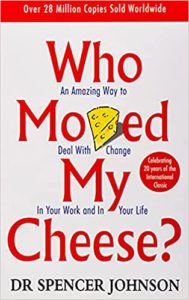
By Dr. Spencer Johnson
Publisher: Vermilion
ISBN-10: 0091816971
By Chuck McPherson ~ We all experience change in our lives. It can be distressing or rewarding, depending on our approach. “Who Moved My Cheese?” is a classic parable that demonstrates in practical terms how to better handle change and avoid pitfalls by practicing a few key principles: anticipate and prepare for change, overcome fears, envision success, and enjoy change. By depicting simple, memorable characters and scenarios, the parable gives you a framework for responding to change successfully.
Teams going through change could benefit from the easy lessons this book has to offer and guiding principles can be key discussion points for the team to work with as they go through change or prepare to go through change.
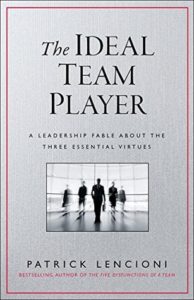
By Patrick Lencioni
Publisher: Jossey-Bass
ISBN-10:1119209591
By Tracy Emmerich ~ This is an easy and fun book to read! The first half of the book is based on a character (Jeff Shanley) who leaves the high-tech business behind to learn and eventually take over his uncle’s construction business (based on a fictional company in Napa!). Jeff has business smarts but knows nothing about construction. Jeff has been working with his uncle learning the ropes for about two months when his uncle informs him that due to health reasons, he must step away from the family business. He assures Jeff that he has faith in him to run the business. Oh, and by the way, the company just landed two large projects, they don’t have the staffing, and cash flow is short because of delays and problems on one of their projects.
The book follows Jeff and his executive team in the way they process issues they have faced, including high turnover and project delays. The team determines that successful employees all have the same “virtues” that make them strong team players (Hungry, Humble, and Smart about people). They evaluate current employees to clarify who on their team has all of these virtues; if they don’t have these virtues, can they be taught? If not, they show how to help them find a job that does not require being a team player. They also make it clear that the company embraces these virtues and if someone does not have these or is unwilling to improve on these virtues, then they will not like working for this company because it is who they are; it is their culture.
The second half of the book gives examples and suggestions on how to apply the team player virtues when hiring and evaluating current employees, how to develop an employee who is lacking in one or more virtues but most important, embedding the model into an organization’s culture.
If the culture of your organization aligns with the three virtues identified in the book – humility, hungry, and smart and you are looking to build or enhance your team with this type of team member, the book gives examples of interview questions and outlines how to evaluate and develop your team players to build the desired culture you want for your organization.

By Chip Gaines
Publisher: HarperCollins
ISBN-10: 0785237914
By Susana Morales ~ I love meeting new people and learning from them. When I go to a network event, which we all know has been a long time since that has happened, I meet people and ask about their stories. I believe networking is about building relationships that stand the test of time which is why I picked up Chip Gaines’ book on networking, No Pain, No Gaines. My interpretation of the book is that he talks about finding your purpose and charting your own path in search of your authentic self. And once you know who you are, you can create your network. A strong network, as defined by him, is a set of relationships that stand by you in the good times and especially in the bad times. There are many nuggets of cool information in the book; I chose a few that resonate with me to share with you:
- Success is not just about working hard it is more about what you are working towards.
- There will be seasons that are scary but none scarier than not living life on your own terms.
- Don’t be a comfortable connector and only hang out with the people who are exactly like you. Be a radical connector, be fearless, and be okay with the possible awkwardness of letting new people into your circle.
- Have a strong circle/network.
- The currency we should be offering one another should be vulnerability and understanding not, “What can you do for me?”
- Don’t let fear limit your potential and ask yourself what great things would come to you if fear wasn’t part of the equation.
How do you start building a strong network? Funny thing about creating your network, it’s advice which I think we all know. If you are the most driven in your network, you need a new network. If you are the strongest leader in your network, you need a new network. If you are the smartest in your network, you need a new network. You need to surround yourself with people who will challenge you to reach your full potential all of the time and every time.

By Tracy Maylett, EdD & Matthew Wride, JD
Publisher: John Wiley & Sons, Inc.
ISBN-10: 1119294184
Introduction
By Tracy Long ~ Attracting and retaining great talent has always been an issue, but even more so with the recent challenges of a post-COVID recession and trends like the “Great Resignation.” It’s not enough to have competitive pay and benefits when there are so many companies vying for a small talent pool. Organizations looking for a competitive advantage would do well to embrace the research and insights from The Employee Experience.
“A well-designed Employee Experience is about creating a better future, rather than focusing obsessively on keeping employees from becoming dissatisfied through perks, employee bonuses, and the like.”
Building upon their success with MAGIC: Five Keys to Unlock the Power of Employee Engagement, Tracy Maylett and Matthew Wride guide us through three critical components of the Employee Experience (EX):
- Expectation Alignment
- The Three Contracts
- Trust
Expectation Alignment
Disengagement (and turnover) results from unclear or unmet expectations and, according to Maylett and Wride, this misalignment increases over time unless the gap between what an employee has been promised and what the employee thinks has been promised has been identified and aligned.
“In the absence of clearly defined expectations, we find or create expectations to fill the void.”
The book explores the symptoms and causes of expectation alignment dysfunction and offers five proven preventative measures and a framework to improve the misalignment.
The Three Contracts
Contracts are the implicit and explicit expectations between relationships. The Employee Experience takes this further by diving into the subcontracts of the Brand Contract, the Transactional Contract and the Psychological Contract and looks at warning signs that the contract is in jeopardy.
Simply stated, the brand contract is your public face and is made up of all the implied promises of your brand messaging. This message helps attract candidates. The transactional contract is an explicit agreement about the terms of the relationship which can be written or verbal. The psychological contract underscores the unstated expectations and beliefs in a relationship and has the most potential to affect the EX. In the absence of clear messaging and alignment in the first two contracts, employees assume the psychological contract rules. When it is violated, employees disengage.
Trust
According to Maylett and Wride, when a “Moment of Truth” happens (something that tests the validity of the contracts) employees will learn whether their employer/supervisor keeps their promises or not. The reward for increased trust is agility; a prized quality in any organization.
This book provides clear, real-world organizational stories and research to highlight the lessons which makes it very relatable and easy to read. In working with managers, I find that unclear or misaligned expectations are the root of many employee relations issues. This book provides managers with tools to understand the connection between expectation alignment and employee engagement, to identify and correct violations of the three contracts, and to build trust so that employees have a meaningful experience, which in turn, creates high-performing, loyal, mission driven employees. I highly recommend it for all managers.
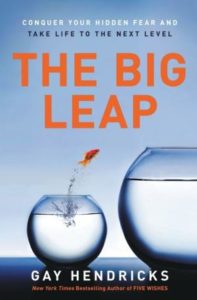
By Gay Hendricks, Ph.D.
Publisher: HarperCollins
ISBN-10: 100061735363
By Jen Chelini ~ Gay Hendricks speaks to the ultimate life roadblock – the “Upper Limit Problem”, a negative emotional reaction that occurs when anything positive enters our lives, not only preventing happiness but stopping us from achieving our goals. Gay Hendricks addresses this problem through a simple program that identifies four fears that prevent us from reaching our upper limit, guides us in learning a new set of powerful skills and habits, and eventually frees us to reach our true potential. Hear from rock stars to Fortune 500 executives who identify their fears and break through their limitations to achieve their true greatness and enjoy financial, love and life successes.
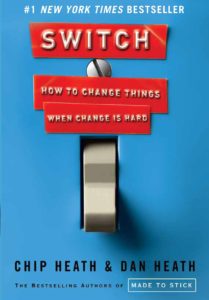
By Chip Heath & Dan Heath
Publisher: Crown Business
ISBN-10: 0385528757
By Scott Ormerod ~ Built on the concept of a Rider, Elephant, and Path, the Heath brothers bring to light how individuals manage change through their rational side (The Rider), their emotional side (The Elephant), and their journey to change (The Path). Our rational side helps us to find the bright spots within ourselves and our work life, it shows us how to script our critical moves, and it points us to the destination where we want to head in the near-future. When our emotional side is engaged, we will find the feeling of the change, shrink the change to make it manageable, and grow our people to be part of the change. Finally, with the path side of change, we can tweak the environment, build habits to support the change, and form systems and processes to keep the change going. With each element of the change model, the authors delight the reader with relevant stories and the outcomes individuals and organizations have experienced as they walk through the change model.
This book is a wonderful tool to help your organization and yourself understand change AND it also helps you create the path for successful change. The approach and applications can fit any organization and serve as an inspiration during a change experience.
Another aspect that I particularly appreciate is the many tools the Heath brothers have developed to support the reader and teams to implement the change model. Their website resources page (click here) contains downloadable tools that you will appreciate and use.
Personally, I have used this book many times to support our clients as they navigate the path of change. Read it and see how you can affect change in yourself and your organization.
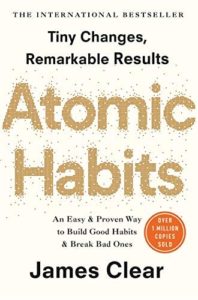
By James Clear
Publisher: Penguin Random House
ISBN-10: 0735211299
By Judy Coffey ~ When working with clients many will acknowledge their less-than-ideal habits, and how difficult it is to change the routine. According to the author, individuals do not rise to the level of their intended goals, not because they don’t want to change, but because they have the wrong system for change.
An atomic habit or routine is small and easy to accomplish. The change you make might seem unimportant at the time, but if you are willing to stick to the simple changes, one can see remarkable results going forward.
For example, one individual was unable to focus the team on financial performance, their goals were not aligned and meetings were spent arguing whose program would need to be eliminated or changed. According to the book, it is a simple two-step process: decide what type of leader you want to be, make small changes and prove to yourself a win. This individual built better habits around meetings, agendas and ultimate outcomes.
The book discusses:
- An atomic habit is easy and an incredible source of power
- Bad habits repeat themselves again and again
- Changes made to habits will compound into remarkable results
Five Big Ideas for better results:
- Habits are the compound of self -improvement
- If you want better results focus on your systems
- The most effective way to change your habits is to focus on what you want to become
- Understand the Four Laws of Behavior: make it obvious, make it attractive, make it easy, and make it satisfying
- Environment is the invisible hand that shapes human behavior
Atomic Habits will help reshape the way you think; gradually your habits become associated with the entire context surrounding the behavior and the context becomes the “cue”. Whether you are an athlete looking to win a championship, a leader hoping to achieve maximum efficiency within your organization, or an individual looking to reduce or eliminate bad habits, this book will give you tools and techniques to support transforming your habits.
***
Leap Solutions is a diverse group of highly skilled management, organizational development, and human resources, and executive search and recruitment professionals who have spent decades doing what we feel passionate about helping you feel passionate about what you do. Our HR specialists can help you get a handle on the ever-changing COVID-19 guidelines, programs, and legislation that may impact you and your employees. We are available to work with you to develop practical solutions and smart planning decisions for your organization’s immediate, near, and long-term needs.
To print this article, click here


Susana Morales | August 12, 2021
In our workplaces of today, individuals are exploring the meaning of work, their contribution, career satisfaction, and under the COVID view, evaluating their future selves. The pandemic has caused individuals to reflect and soul search about what could or should be different in their future. At Leap Solutions, we support individuals through coaching and teams through team strengthening to identify and set their Destination Postcard. We encourage introspection and the development of a clear path to achieve the individual and team vision of their best selves. We provide the tools you need to create the Destination Postcard for the “Future You”.
In this issue of our newsletter:
- The individual Destination Postcard
- The team Destination Postcard
- Setting yourself up for success
The Destination Postcard
We need change to grow as individuals, leaders, and teams, and when we know what that change looks like, it’s more likely that we will do it and stick to it, whether we’re starting a new job, moving to a new city, creating or updating a desired team culture, or starting a big project.
Change is the perfect opportunity to create a destination postcard, a vivid picture from the near-term future that shows what could be possible. It’s a concept from the book “Switch: How to Change Things When Change is Hard” by Chip and Dan Heath. https://heathbrothers.com/books/switch/ The destination postcard makes change manageable and creates a path for change to happen.
Your destination postcard creates a picture of where you want to be after the change. Or when you know there is a destination you want to reach and you want that clear, vivid picture of how you are going to get there. You wouldn’t take a vacation without knowing your destination or where you want to explore. Creating change, embracing change that you create, is the catalyst for your growth, the ‘I’m going to do it’ beginning. Creating your destination postcard provides the path to that place you envisioned you’d be.
But, without a clear vision of the destination, change will not happen. Without envisioning the journey and how you want to get there, it is impossible to create change.
The journey to your planned destination starts with developing goals that inspire and are also SMART – Specific, Measurable, Attainable, Relevant, and Time-specific. Often, development plans align with a company’s goals and shape our own vision but, to be impactful, a development plan needs skillful development and feedback, and not just when the annual review is conducted.
Here’s the Process:
1. Understand what is going to change or where you want to go as an individual or a team
2. Do some reflection to create vision, values, and passion for you and for your team
3. Ask yourself these questions:
- What does success look like?
- What does your realized self or team look like?
- What fulfills you and your team?
The Individual Destination Postcard
Here’s an example of an individual’s Destination Postcard:
My Vision
My vision for the end of 2021 is that I would have started my new job and grown as a professional. I am a strong manager and leader. I have also grown personally and I am accountable to myself, my new company, and others around me.
My Values
My values are accountability, compassion, life-long learning, and empathy. My values anchor my work professionally and as personal goals.
My Passion
I am passionate about helping others and that is why I will volunteer 5 hours per month to a nonprofit that does work that aligns with my values.
SMART Goals for life priorities
Work Focus – I will work 8 hours a day and focus on reaching my quarterly outcomes for sales.
Family Focus – I will spend the weekends with the kids and go to the park on Saturdays. I will be home by dinner time every day of the week.
The Team Destination Postcard
The team destination postcard process is essentially the same as for your personal destination postcard, but requires team-focused introspection to uncover and agree upon direction, goals, and team commitment to the destination. Your team’s destination postcard can start with the end in mind, and affirm the team through a series of questions.
The team process:
1. Understand what is going to change or where the team wants to go.
2. Team Discovery
- What are the team values and their meaning to us?
- What is the vision for the team (where are we collectively headed)?
- What brings passion to the team?
3. Team Desired Outcome questions:
- What does success look like?
- If we achieve our vision, what will our team have accomplished?
- How will our culture as a team be defined?
- To reach our outcomes, what are our team priorities?
Here’s an example of a team Destination Postcard:
Team Vision
Create a clear message for our clients and partners so they can join our organization.
Team Values
We value trust, commitment, and our value proposition.
Team Passion
We are passionate about creating a message that will draw new clients and partners to our business.
SMART Goals for Team Focus
We will work as a team and meet once a week until we launch our new message by December.
For individuals and teams, remember these four areas for creating your destination postcard:
Vision: What is YOUR north star?
Values: What anchors you?
Passion: What makes you passionate about your values and vision?
Priorities: What themes fuel your vision?
Setting Yourself Up for Success
A destination postcard sets you up for success and leads you in the right direction. Without a clear vision of the destination, change will not happen. Without envisioning the journey and how you want to get there, it is impossible to create change.
Individually, I use my destination postcard to guide my career-life balance. It includes how I want to grow as a consultant and provide high-quality services for our clients; speaks to my aspiration to balance my life and find time to volunteer in the community; puts a focus on personal health; and reminds me to spend time with family and friends.
Our clients use their destination postcards to guide cultural change initiatives, team building and development, and changes in leadership. Their destination postcards serve a critical purpose as they experience change and innovation. They know where they want to go and how to get there.
A coaching client used her destination postcard to guide her in the next level of her career. Abby was recently promoted to a managerial position. She knew what kind of manager she wanted to be and knew what kind of culture she wanted to create for her team, but she didn’t know how she was going to get there. We worked with her to develop her destination postcard and create goals for herself, and the team. She then had direction, knew she wanted to be a great manager, and needed to invest in professional development to reach her goal.
She also wanted her team to appreciate and practice collaboration, so she made these a priority by modeling what collaboration was to her team. Her destination postcard enabled her to move in the best direction for her and her team. She made her vision real by centering herself, understanding the values, vision, mission, and listing her priorities using SMART goals. Today, Abby excels at her job and has a team culture to be proud of.
Let’s get you started on yours and your team’s Destination Postcard. Reach out to us and we’ll guide you through the process, support your desired change, and celebrate with you when the change train arrives at your destination!
***
Leap Solutions is a diverse group of highly skilled management, organizational development, and human resources, and executive search and recruitment professionals who have spent decades doing what we feel passionate about helping you feel passionate about what you do. Our HR specialists can help you get a handle on the ever-changing COVID-19 guidelines, programs, and legislation that may impact you and your employees. We are available to work with you to develop practical solutions and smart planning decisions for your organization’s immediate, near, and long-term needs.
To print this article, click here


Scott Ormerod | August 30, 2019
Change isn’t just inevitable…it’s also vital to continued growth, success and prosperity.
Coaching can be a great way to ready yourself not only to accept change that comes your way but to embrace, influence and even drive change for the betterment of your organization and yourself.
When Change Hits
Often, change is thrust upon you—it’s not necessarily your idea and not necessarily welcome. But whether you’re facing an unanticipated change in employer, position, team, boss, peer, systems or processes, you can enlist a seasoned coach to help you:
- Overcome resistance. Many people have a natural tendency to resist change or get caught up in negativity and drama surrounding it. A coach will work with you to examine your resistance and separate known factors, truth and reality from perceptions, preconceived notions and fears.
- Take control. Your coach will pique your curiosity about what’s possible with impending change and show you that you are both in charge of and responsible for how you respond to it. Together, you’ll find ways to stay engaged and begin to address change from a place of strength, commitment and zeal.
- Stay accountable. You’ll learn just how much you can influence change when you are willing to lean into it and be proactive about it. Your coaching partner will challenge you to look for solutions and creative ways to make change work most effectively and successfully for you and your organization.
- See opportunity. Times of change are always times to consider what else might be doable. A quality coach will open your eyes to opportunity—maybe it’s the chance to retool a position to better serve your needs, reprioritize goals to reflect what’s truly important, save money or harness new technological advances. You’ll find that, with skilled coaching, guidance and support, change can lead to unexpected freedom and breakthrough.
- Serve as model. As you thrive through times of change, others will likely take notice and be inspired to join you. What will emerge is a communal spirit of cooperation, collaboration and progress that will surely push you all, as individuals and as an organization, toward a better future.
Driving Change
A great coaching partnership will empower you to cope confidently with even the most overwhelming of changes and move forward with intention, assuredness and positivity.
It will also motivate and equip you to envision and drive well-thought, well-managed change. Your coach will encourage you to:
- Be strategic. All too often, people make changes for the wrong reasons—perhaps they’re attracted to what’s shiny and new, they’re fearful that something unwanted might happen or they’re restless and choose to institute change for change’s sake. A coaching partner challenges you to think strategically about your intentions and works with you to determine whether you really need change as well as how best to go about implementing it.
- Strike a balance. The best kind of change achieves the ideal balance between doing things “the way we’ve always done them” and reinventing the wheel. Well-executed change honors the past and is based on a full understanding of what works (and what doesn’t), what’s already been tried (and what hasn’t) and how people are feeling about where things are and where they could be. It takes well-informed, calculated risks while acknowledging and celebrating the best of the old and reflecting and embracing the most promising of the new.
- Be thoughtful. Compassionate change leaders will recognize and appreciate how change impacts a company and its people. Stay particularly mindful of generational differences among employees that might affect reactions and approaches to change.
- Communicate well. Be transparent and straightforward about your reasoning behind any change, and be clear about your expectations. Make sure employees are comfortable voicing concerns, opinions and ideas and that you’re genuinely open to hearing them.
- Solicit buy-in. Support all parties to the best of your ability through change. Offer any resources they may need, including additional training, education, technology or tools for success.
- Recognize new possibilities. One change will often uncover another. Don’t be surprised, for instance, if a well-managed change spotlights a rock-star employee who simply didn’t have space and opportunity to shine before!
Flourishing Through Change
Sometimes change happens to you, and sometimes it’s well thought, well planned and well-executed. You need to be able to flourish through both. But even under the best of circumstances, change can be hard and often feels too fast and too furious.
The experts at Leap Solutions have decades of coaching experience, and we bring calm, clarity and efficiency to your change process. We also bring invaluable distance, outside perspective and insight while asking thoughtful questions, uncovering how change truly impacts you and everyone around you, challenging your thinking, and, together, imagining and realizing the incredible new opportunities that change can afford you and your organization.

Click here to print this newsletter!
https://leapsolutions.com/practice-areas/executive-coaching/
For further reading, check out: No Ego: How Leaders Can Cut the Cost of Workplace Drama, End Entitlement, and Drive Big Results by Cy Wakeman, St. Martin’ Press, 2017





















